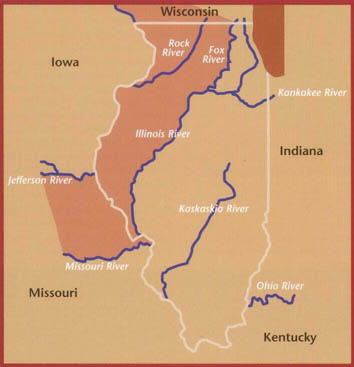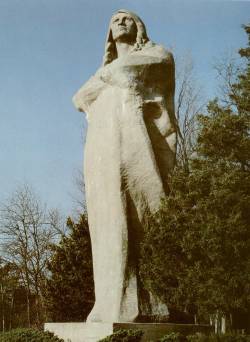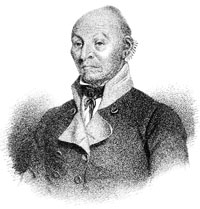|

|
|
Black Hawk: Myth and Reality |
| According to his 1833 autobiography--perhaps the only reliable source we have concerning his early life--Black Hawk was born at Saukenuk, the Sauk village located at the confluence of the Rock and Mississippi rivers (near what is now the city of Rock Island, IL), sometime around the year 1767. He earned distinction as a war leader in conflicts between the Sauks and their neighbors and against the United States—as an ally of the British during the War of 1812 and as an ally of Tecumseh during the Shawnee leader’s pan-Indian campaign. Black Hawk is best known, however, for his own resistance to American expansion in Illinois. |
As a result of a very questionable treaty signed by a few Sauk and Mesquakie leaders in 1804, the United States claimed ownership of all Sauk territory east of the Mississippi -- including their main village at Saukenuk. Black Hawk considered the 1804 Treaty to be invalid and, along with no more than a third of the Sauks, a few Mesquakies, and some Kickapoo and Winnebago allies--perhaps just over 1000 in all, employed both peaceful and hostile means in his attempts to prevent American incursion into land he considered his own. The tense relations between Whites and Indians on Illinois’ northwest frontier erupted into open hostilities in 1832. |
 |
After an initial "battle" that came to be known as Stillman’s Run, Black Hawk and his band led American soldiers on a six week chase before he was finally captured in what is now Wisconsin. Soldiers and militiamen along the Bad Axe and Mississippi rivers massacred most of his allies as they tried to escape to the relative safety of the West. Click here to view the text of the Sac and Fox Treaty of 1804
In federal custody, Black Hawk and the other leaders of his band were held for a time at Jefferson Barracks near St. Louis—where they proved quite the draw for St. Louis residents anxious for a glimpse of the "hostile Indians." Newspapers even went so far as to announce the times during which Black Hawk and his fellow captives would be outside and visible to visitors. After several months, apparently to demonstrate to them the power of the United States, the prisoners were sent on a tour of the Eastern cities—on which they attended plays, spoke to crowds, and were shown the highlights of 1830s America. They even had a brief audience with President Andrew Jackson. Spectators followed them wherever they went and Black Hawk and his fellows often complained of the noise and the crowds. Everything the Indians did in the East—or everything they were said to have done—was considered newsworthy. Many newspapers published accounts of their visit under the heading "Blackhawkiana." Click here to read some examples of "Blackhawkiana" On his return to Rock Island in 1833 (Saukenuk had been settled in the meantime by Americans who stripped the village of its name, though some occupied dwellings left vacant by the forcibly-removed Sauks), Black Hawk asked for assistance in recording the story of his life—in the hope, he explained "that the people of the United States…might know the causes that had impelled him to act as he has done, and the principles by which he was governed." The work that resulted, The Life of Ma-ka-tai-me-she-kia-kiak, is an incredibly complicated document. It ranks as the first—and for several decades, the only—autobiography prepared for a general audience by a non-Christian Native person, one who had stood up to and been defeated by American military forces yet was not only uninterested in assimilation into American culture but who remained openly opposed to it. |
Black Hawk in American Dress Presented to Him by President Andrew Jackson |
Yet his story could only be presented to an audience through the mediation of a Metis interpreter and an American editor—the troubling presence and intervention of whom clearly influenced the production of the text as well as its final form. The means of the autobiography’s production—spoken by Black Hawk, translated from Sauk into English by Antoine Leclaire (whose first language was French, though he spoke as many as seventeen languages in all), re-worked and polished by John B. Patterson (a newspaperman), then re-translated into Sauk for Black Hawk’s approval—raise important concerns about the work’s authenticity. Though readers, scholars, and even (through the auspices of the Indian Claims Commission) the federal government have questioned whether Black Hawk played any significant role at all in the preparation of The Life, it remains one of the few extant documents that tell us anything about the Sauk war leader—and the only one that tells us anything about his early life or provides something even remotely resembling a Sauk perspective accessible to a general audience. |
Even though Black Hawk’s life is better documented than those of most Native people from his day—and than most non-Native people as well—it is still often difficult for us to sort out what really happened in any given moment of it. During and after his conflict with the United States—by which time Black Hawk was already an old man—there may have been a torrent of verbiage about Black Hawk’s activities and motivations, but the sources often contradict one another. Newspaper accounts, for example, are often unreliable because they are written far from the scene of action and well before detailed (or accurate) reports arrived. Black Hawk’s own version is not only problematic because of the methods used in its production but because its author writes from a clearly biased perspective. Likewise biased are memoirs written by American veterans of the conflict against Black Hawk, most of whom did not record details of their experiences until several decades after it had ended. As a result, these sources present us not with a single Black Hawk, but with several Black Hawk's—perhaps none of which accurately reflect the original. Click here to read several very different descriptions of the "Battle of Stillman's Run"
The only other primary sources we have to help us learn about the "real" Black Hawk, are even further removed. Many archives, for example, contain many "Old Settler Accounts"—oral histories collected by amateur historians to document what life was like before colonization and settlement on a massive scale, many decades of American development, and John Deere’s steel plow changed the face of the Illinois country forever. These are usually nostalgic reminiscences of a time long passed, usually offered by people well into their seventies and eighties. Usually, their accounts provide us glimpses of a history clearly tinted by memory’s rose-colored glasses. In many cases, these "Old Settlers" were themselves eyewitnesses to the events they describe so their stories cannot be ignored…but they cannot be taken at face value either. Click here to read more about "Old Settler" accounts and their value as historical sources.
|
More readily accessible than archived memories are the tangible monuments erected to commemorate Black Hawk and the events in which he took part. The highways that now follow the route taken by Black Hawk and his band through northwest Illinois and southwest Wisconsin have been designated the "Black Hawk Trail". Several monuments describing battles and other wartime incidents dot the landscape. <Image: Stillman Marker> Several local businesses use Black Hawk’s name and likeness to promote themselves <Image: Credit Union, Corn sign> Local legends grew up about Black Hawk’s—usually tenuous or nonexistent—connections to particular landmarks, including "Black Hawk’s Tree" in Prairie du Chien, WI. In 193?, the State of Illinois named a state park for him near downtown Rock Island—and in the process ironically protected a portion of Black Hawk’s country from further development. But the most infamous—and the most visible—instance of Black Hawk’s continued presence on the landscape must surely be Lorado Taft’s colossal "Black Hawk" statue located near Oregon, IL. |
 |
There
can be no doubt that today’s residents
of Illinois feel some degree of reverence for Black Hawk—whether
or not they actually know much about him. But Black Hawk is also commemorated
by people living far away from Illinois. The Sac and Fox Nation of Oklahoma,
for example, uses Black Hawk’s name (in his own language) on their
national flag—along with that of his descendent, Olympic athlete
Jim Thorpe. Though a dissident figure during his own time, Black Hawk
is now generally seen as a national hero by Sauk people. Many associate
him with the Sauk values and traditions that they have taken such great
efforts to preserve even after the nation’s removal to Oklahoma. |
Ma-ka-tai-me-she-kia-kiak,
the man better known to us as Black Hawk, has become a symbol…perhaps more potent in death
than he ever was in life. But he means different things to different people.
Among other incarnations, Black Hawk has been a bloodthirsty outlaw, a
noble savage, a stubborn warrior, a product spokesperson, a traditional
hero, an obstacle to civilization, and a national patriot. Which of these
manifestations is "real" has become, for the most part, irrelevant.
To the question, "Who is Black Hawk?" there is no easy answer.
Black Hawk has proven malleable. He seems now to be whatever folk need
or want him to be. |
| |
Department
of Anthropology |
copyright © 2002
University of Illinois, All rights reserved. |

